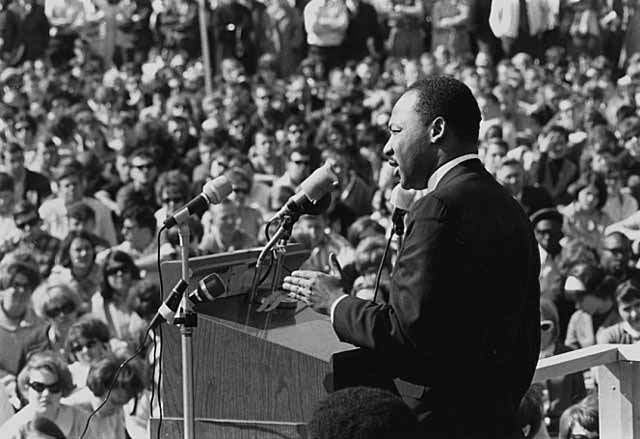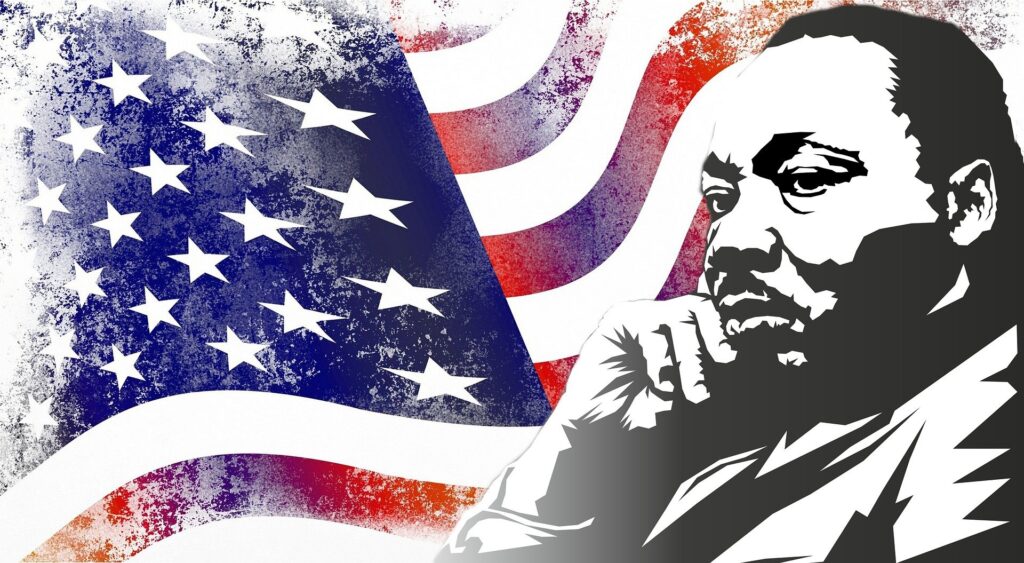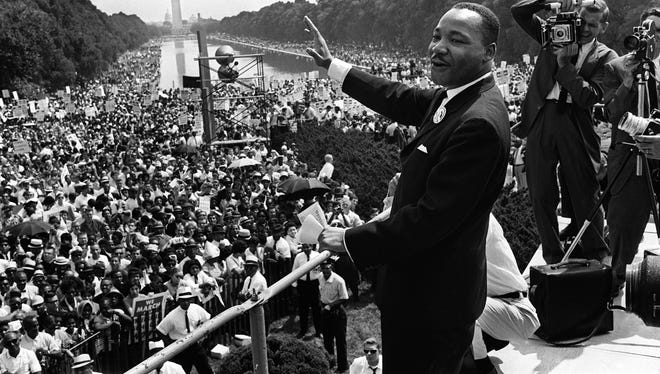Blog > Celebrate Martin Luther King Day Virtually With Kanopy
Posted January 14, 2021

Martin Luth King Day is Monday, January 18th . Here is a selection of movies that you
can watch for free on Kanopy:
1) Dr. Martin Luther King, Jr: A Historical Perspective: He was the conscience of the
struggle for civil rights–and one of its many heroic martyrs. this documentary
offers a one-of-a-kind examination of Dr. King's extraordinary life. Using rare and
largely unseen film footage and photographs, this film (endorsed by the King
Foundation) explores how Dr. King's ideas, beliefs and methods evolved in the
face of the rapidly changing climate of the Civil Rights Movement. To study Dr.
King's compelling and magnificent life is to understand that social change and
enlightenment are brought about only by the overwhelming force of the human
spirit.
2) Share a Vision: Martin Luther King Jr. “I Have a Dream” speech is one of the
most iconic speeches in modern history. More important: It’s the perfect example
of a speech with the power to inspire. In this lecture, discover ways to articulate
and share your personal vision with an audience.
3) Martin Luther King, Jr: I Have A Dream: This historical compilation features
highlights of major speeches given by the Rev. Martin Luther King, Jr., Lincoln
Memorial, Washington D.C. – August 28, 1963, Brown Chapel, Selma, Alabama –
March 8, 1965, Final Speech, day before Dr. King`s Assassination – April 3,
1968, Robert F. Kennedy Eulogy – April 4, 1968
4) Martin Luther King: Death In Memphis: In April, 1968, Rev. Martin Luther King
was at the height of his public popularity. But J. Edgar Hoover, the head of the
FBI, had an obsessional hatred of King and was determined to silence him. On
April 4th, King was assassinated with one perfect shot. Clearly James Earl Ray
fired that shot but was he just the fall-guy? Despite disturbing evidence, the case
has never been reopened.
5) Martin Luther King, Jr: We Shall Overcome: This historical compilation features
highlights of major speeches given by the Rev. Martin Luther King, Jr.
6) Martin Luther King, Jr: Been To The Mountaintop: Seen and heard in this original
footage are the highlights of dramatic speeches and conversations spanning
1956 to 1968, including his last address on April 3, 1968, the night before his
assassination in Memphis, Tennessee.
7) In Remembrance of Martin: Personal comments from family, friends, and
advisors fill this remarkable documentary honoring Dr. Martin Luther King, Jr.
Coretta Scott King joins the Reverend Ralph Abernathy, Julian Bond, Jimmy
Carter, the Reverend Jesse Jackson, Senator Edward Kennedy, John Lewis, Bishop Desmond Tutu, and Andrew Young, who recall Dr. King’s career and trace his leadership in the civil rights movement. Includes portions of his “I Have a Dream” speech.
8) King: A Filmed Record Part 1 and Part 2: Constructed from a wealth of archival
footage, KING: A FILMED DOCUMENTARY is a monumental documentary that
follows Dr. Martin Luther King, Jr. from 1955 to 1968, in his rise from regional
activist to world-renowned leader of the Civil Rights movement. Rare footage of
King’s speeches, protests, and arrests are interspersed with scenes of other
high-profile supporters and opponents of the cause, punctuated by heartfelt
testimonials by some of Hollywood’s biggest stars. KING was originally presented
as a one-night-only special event on March 20, 1970, at an epic length of more
than three hours (plus intermission). Since that time, the film has occasionally
been circulated in a version shortened by more than an hour. Newly restored by
the Library of Congress, in association with Richard Kaplan, and utilizing film
elements provided by The Museum of Modern Art, the original version of King
can again be seen in its entirety, mastered from the 35mm preservation negative.

9) Fighting Back 1957-1962: States’ rights loyalists and federal authorities collide in
the 1957 battle to integrate Little Rock’s Central High School, and again in James
Meredith’s 1962 challenge to segregation at the University of Mississippi. Both
times, a Southern governor squares off with a U.S. president, violence erupts —
and integration is carried out.
10) Ain’t Scared of Your Jails 1960-1961: Black college students take a leadership
role in the civil rights movement as lunch counter sit-ins spread across the South.
“Freedom Riders” also try to desegregate interstate buses, but they are brutally
attacked as they travel.
11) No Easy Walk: The civil rights movement discovers the power of mass demonstrations as the Rev. Martin Luther King, Jr. emerges as its most visible leader. Some demonstrations succeed; others fail. But the triumphant March on Washington, D.C., under King’s leadership, shows a mounting national support
for civil rights. President John F. Kennedy proposes the Civil Rights Act.
12) Mississippi: Is This America?: Mississippi's grass-roots civil rights movement
becomes an American concern when college students travel south to help
register black voters and three activists are murdered. The Mississippi Freedom
Democratic Party challenges the regular Mississippi delegation at the Democratic
Convention in Atlantic City.
13) Bridge to Freedom: A decade of lessons is applied in the climactic and bloody
march from Selma to Montgomery, Alabama. A major victory is won when the federal Voting Rights Bill passes, but civil rights leaders know they have new challenges ahead.
14) The Time Has Come: After a decade-long cry for justice, a new sound is heard
in the civil rights movement: the insistent call for power. Malcolm X takes an
eloquent nationalism to urban streets as a younger generation of black leaders
listens. In the South, Stokely Carmichael and the Student Nonviolent
Coordinating Committee (SNCC) move from “Freedom Now!” to “Black Power!” as the fabric of the traditional movement changes.
15) Two Societies: Martin Luther King, Jr. and the Southern Christian Leadership
Conference (SCLC) come north to help Chicago’s civil rights leaders in their
nonviolent struggle against segregated housing. Their efforts pit them against
Chicago’s powerful mayor, Richard Daley. When a series of marches through all-
white neighborhoods draws violence, King and Daley negotiate with mixed
results. In Detroit, a police raid in a black neighborhood sparks an urban uprising
that lasts five days, leaving 43 people dead. The Kerner Commission finds that
America is becoming “two societies, one black, one white, separate and
unequal.” President Lyndon Johnson, who appointed the commission, ignores
the report.
16) Power!: The call for Black Power takes various forms across communities in
black America. In Cleveland, Carl Stokes wins election as the first black mayor of
a major American city. The Black Panther Party, armed with law books, breakfast
programs, and guns, is born in Oakland. Substandard teaching practices prompt
parents to gain educational control of a Brooklyn school district but then lead
them to a showdown with New York City’s teachers’ union.
17) The Promised Land: Martin Luther King stakes out new ground for himself and
the rapidly fragmenting civil rights movement. One year before his death, he
publicly opposes the war in Vietnam. His Southern Christian Leadership
Conference (SCLC) embarks on an ambitious Poor People’s Campaign. In the
midst of political organizing, King detours to support striking sanitation workers in
Memphis, where he is assassinated. King’s death and the failure of his final
campaign mark the end of a major stream of the movement.
18) Let Freedom Ring: The Civil Rights movement becomes the most effective
social movement in U.S. history. During this era, Martin Luther King marches on
Washington, and Little Rock’s high school is integrated. John F. Kennedy is
inaugurated as President of the United States.

19) I Have a Dream: The Nature of Great Speaking: This fascinating film analyzes
why Martin Luther King Jr.’s extraordinary 1963 speech was so effective. The film combines film sequences from the speech, historical photos from the Civil Rights movement, and graphics with an appreciative and probing examination of King’s use of words and images.
20) Speeches That Changed The World: Words and delivery can combine to
galvanize an audience, creating ‘I remember where I was when…” moments. JFK
at the Brandenburg Gate or Martin Luther King at the Lincoln Memorial provide
unforgettable examples that still stir today. This collection of classic speech
excerpts contains not only inspiring orations to democratic freedom and the
noblest aspects of human endeavor, but also some of the darkest and most
despicable speeches delivered in modern times.
21) Activists: They have made a difference and revolutionized the world. They come
from all walks of life and from all corners of the globe. These remarkable
individuals have pioneered, developed and forever improved their industry and
the world in which we live. Engaging and relevant, these individuals will change
the way you view the world, and remind you that it only takes one person to
make a difference. Martin Luther King, Jr., Nelson Mandela, Mahatma Gandhi,
Aung San Suu Kyi, Che Guevara
22) Brother Outsider: On November 20, 2013, Bayard Rustin was posthumously
awarded the prestigious Presidential Medal of Freedom by President Barack
Obama. Who was this man? He was there at most of the important events of the
Civil Rights Movement – but always in the background. BROTHER OUTSIDER
asks “Why?” It presents a vivid drama, intermingling the personal and the
political, about one of the most enigmatic figures in 20th-century American
history. One of the first ‘freedom riders,’ an adviser to Dr. Martin Luther King, Jr.
and A. Philip Randolph, organizer of the march on Washington, intelligent,
gregarious and charismatic, Bayard Rustin was denied his place in the limelight
for one reason – he was gay. This film contributes a fascinating new chapter to
our understanding of both progressive movements and gay life in 20th-century
America.
23) A. Philip Randolph: For Jobs and Freedom: Ask most people who led the 1963
March on Washington and they'll probably tell you Martin Luther King, Jr. But the
real force behind the event was the man many call the pre-eminent black labor
leader of the century and the father of the modern civil rights movement: A. Philip
Randolph. Randolph believed that economic rights was the key to advancing civil
rights. A. PHILIP RANDOLPH: FOR JOBS AND FREEDOM takes viewers on a
tour of 20th-century civil rights and labor history as it chronicles Randolph’s
legendary efforts to build a more equitable society.
24) The Barber of Birmingham: In Academy Award nominated THE BARBER OF
BIRMINGHAM, 85 year-old barber and life-long civil rights activist James
Armstrong looks back on the early days of the civil rights movement and links
those struggles with a previously unimaginable dream — the election of the first
African-American president. Armstrong was the proud proprietor of Armstrong's
Barbershop, a cultural and political hub in Birmingham, Alabama, for more than
50 years. In his small establishment, every inch of wall space was covered with
inspirational newspaper clippings and photographs of his heroes, including
Martin Luther King, Jr., who had his hair cut by Armstrong. THE BARBER OF
BIRMINGHAM tells the larger history and impact of the civil and voting rights
movement through James Armstrong’s personal journey, supplemented by
commentary from other civil rights veterans and vividly illustrated with archival
footage of key events in the movement.
25) Rise!: Rise! examines the long road to civil rights, when the deep contradictions
in American society finally became unsustainable. Beginning in World War II,
African Americans who helped fight fascism abroad came home to face the same
old racial violence. But this time, mass media — from print to radio and TV —
broadcast that injustice to the world, planting seeds of resistance. And the
success of black entrepreneurs and entertainers fueled African-American hopes
and dreams. In December 1955, Rosa Parks refused to give up her seat to a
white man on a city bus in Montgomery, Alabama, heralding the dawn of a new
movement of quiet resistance, with the Reverend Dr. Martin Luther King, Jr. as
its public face. Before long, masses of African Americans practiced this
nonviolent approach at great personal risk to integrate public schools, lunch
counters and more. As the civil rights movement scored one historic victory after
another, non-violence was still all too often met with violence — until finally,
enough was enough. By 1968, Dr. King, the apostle of non-violence, would be
assassinated, unleashing a new call for ‘Black Power’ across the country.

